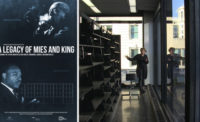“Architecture reflects who we are,” Mina Chow says in her new documentary, Face of a Nation, which premiers at Washington D.C.’s inaugural Architecture & Design Film Festival this week. The film, which makes connections between world fair architecture and national identity, examines the implications of the United States’ waning role in international expositions.
For Chow, who is an architect, the film is in many ways a personal investigation. Having been inspired to practice by photographs of her immigrant parents in front of the grand Unisphere at the 1964 New York World’s Fair, Chow posits that, historically, the United States has seized expos as opportunities to showcase technological prowess and artistic talent. She asserts that through these architectural displays, the international scene had come to view the U.S. as a land of hopeful opportunity.
Since the first world expo in 1851 in Hyde Park, London, universal expositions have become “runways of architecture,” serving as “battlefields for national pride,” says architect James Biber in the film. During the Cold War, the United States used its pavilions to outshine Communist enemies. Jack Masey’s model American kitchen at the expo in Moscow in 1959, Buckminster Fuller’s geodesic dome at the 1967 Montreal Expo, and the inflatable dome of the 1970 Osaka Expo, designed by architect Davis Brody and Chermayeff, Geismar & de Harak (and featuring a lunar rock brought back from the Apollo 12 mission), stand as powerful statements of American creativity and innovation.
But Chow, Biber, and other architects featured in the documentary, including Barton Myers and the late Masey (responsible for designing and organizing some of most memorable U.S. pavilions), argue that the United States’ diminishing effect at world fairs has weakened the image of American ingenuity and ambition. After the collapse of the Soviet Union, a misguided sense of victory had caused the U.S. to cease investing in its presence at expos, and the quality of its pavilions dwindled as funding and oversight became outsourced to private companies prioritizing corporate branding over technological innovation.
In the film, Chow visits the 2010 Expo in Shanghai, where it’s apparent that the United States’ influence at international fairs has been replaced by that of the rest of the world, particularly China, whose pavilion—a 200-foot high building inspired by the shape of an oriental crown, with features such as natural ventilation, a rooftop garden, and rainwater harvesting—was the largest ever built at an expo. France’s exhibition, home to six paintings and a sculpture on loan from the Musée d’Orsay, featured an ornate cross-patterned facade, while Latvia’s pavilion boasted a cylindrical exterior with an Aerodium wind tunnel centerpiece for visitors to enter.
Chow’s thesis moves slowly, but crystallizes when we glimpse the U.S. pavilion, an unremarkable, 60,000-square-foot glass-and-steel structure designed by a Canadian architect, Clive Grout, and funded by private money collected from dozens of multinational corporations. The pavilion isn’t an expression of freedom, but, rather, of entrapped desperation, ingenuousness, and arrogance—perhaps an inadvertent metaphor for what the country currently represents. Through approaching the subject material as an architect investigating the death of the U.S. pavilion, Chow tells the story of a nation undergoing an identity crisis.



